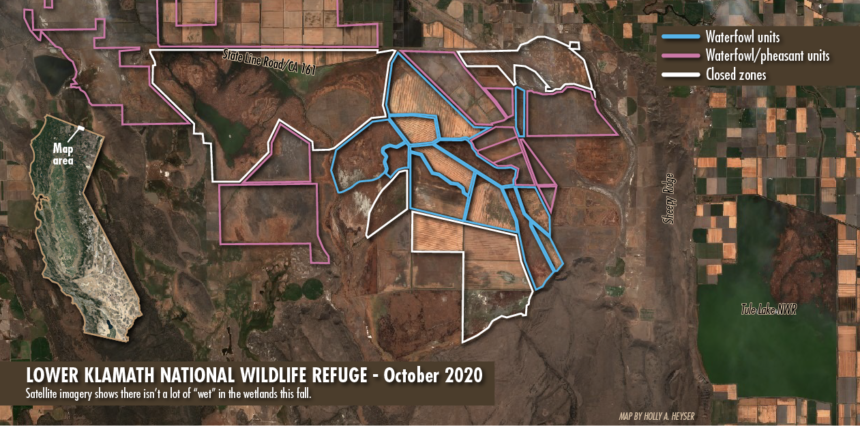
Oct 29, 2020
Lower Klamath NWR: final botulism tally, dismal live bird counts

Lower Klamath was established more than 100 years ago to provide habitat for waterfowl. That's hard to do without water. Click here to see map at full size.
Given how little water the Lower Klamath National Wildlife Refuge got this summer (more about why below), the following should come as no surprise: Aerial surveys show waterfowl counts at the Lower Klamath and Tule Lake National Wildlife Refuges are down 86% this year, according to the U.S. Fish and Wildlife Service.
Lower Klamath is an estimated 85%-90% drier this year than it was last year. The satellite photo above shows very little water on the refuge – so little that the only hunting allowed is in the refuge's grain fields.
The impact of the water shortage on hunters is an asterisk compared with the impact on wetland-dependent wildlife:
- There was less water this spring and summer for rearing broods of ducklings, which is expected to make a dent in the state's beleaguered mallard breeding population.
- There was less water for molting ducks, creating another population bottleneck – without sufficient molt water, more ducks are exposed to predators in sub-par habitat.
- There were fewer places for migrating waterfowl to stop in the Basin and refuel before their final push south for the winter. We've heard many reports of unusually large numbers of ducks and geese being seen in the Central Valley this early in the season, likely because they had to bypass the Basin.
And then there's the botulism. This summer marked the worst botulism outbreak in memory, a disease activated by unusually warm temperatures that struck earlier than usual, and exacerbated by the concentration of molting birds in limited pockets of water, particularly at Tule Lake. Total estimated mortality: 60,552. Here's how that breaks down:
Waterfowl picked up: 18,007, of which 34% were mallards and 17% were green-winged teal.
Non-waterfowl picked up: 2,274, including coots, sandpipers, phalaropes, rails, gulls, ibis and songbirds.
Birds not picked up: Service officials estimated there were more than 8,000 dead birds visible in Sump 1B that could not be picked up prior to hunter access.
Total 60,522: This is double the actual number collected or observed. Service officials estimate that they see or pick up only about half of the dead because many birds die in thick cover where staff and volunteers either can't see or can't get to them.
Why is there a water shortage?
There is a drought in the region this year, which is making the situation much worse. But the root of the problem is man-made: The refuge has no high-priority water rights, and water from the Klamath Project is increasingly being diverted in an attempt – so far unsuccessful – to save three endangered fish species. Click here for more details.
California Waterfowl is fighting for the refuge, with two key goals: helping to secure high-priority water rights for Lower Klamath, and working with stakeholders to develop a plan to more equitably distribute water in the Klamath Basin.
To keep abreast of news about Lower Klamath, click here to sign up for our monthly Save Lower Klamath! newsletter (click here to see the first edition).
To support the fight for the refuge, please click here to make a donation. Your gift will be earmarked specifically for this effort.


